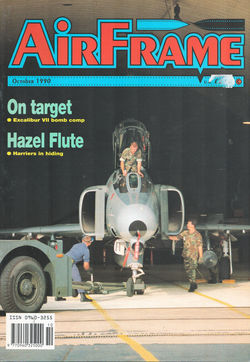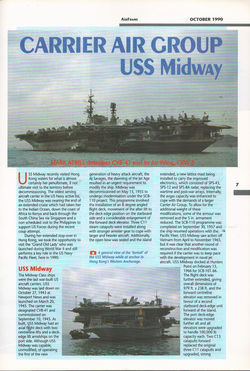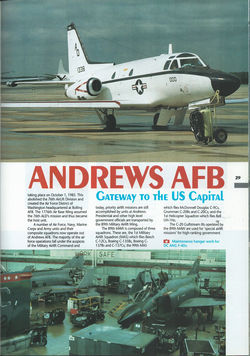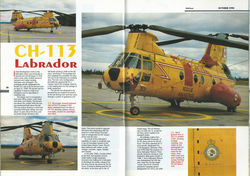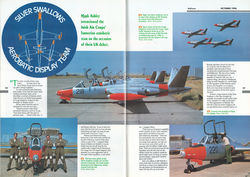AIRFRAME
OCT 90 USS MIDWAY CV-41 ANDREWS AFB F-1E CH-113 LABRADOR CANADA FB-111A IAC
USAFE RF-4C
USS MIDWAY CV-41 US NAVY
AIRCRAFT CARRIER IN THE WESTERN PACIFIC CVW-5 (VFA-151, VFA-192, VFA-19,
VA-115, VA-185, VAQ-136, VAW-115, HS-12)
RAPID DEPLOYMENT ACE MOBILE
FORCE AMF HELICOPTERS: BRITISH ARMY 24 AIRMOBILE BRIGADE
BOSCOMBE DOWN BATTLE OF BRITAIN 50TH
ANNIVERSARY AIRSHOW
HAZEL FLUTE: HARRIER CAMOUFLAGE
USAF FB-111A AARDVARKS MOVE TO
PEASE AFB
ANDREWS AFB: 89TH
MAW, WASHINGTON DC F-4D PHANTOM II, UH-1N, C-137B, C-21A, C-12A, C-9C, C-22)
EIGHTEEN YEAR RESTORATION OF A
WW2 GERMAN LUFTWAFFE MESSERSCHMITT Bf.109G-2
CANADA�S HEAVY-LIFT HELICOPTER
CH-113 LABRADOR
BELGIAN AIR FORCE FAB No.8
SQUADRON & No.42 SQUADRON
USAF McD F-15E STRIKE EAGLE TFW
IRISH AIR CORPS IAC SILVER
SWALLOWS FORMATION AEROBATIC DISPLAY TEAM � FOUGA MAGISTER
McD RF-4C PHOTO PHANTOM USAFE
COLOURS
TUCANO PROPJET TRAINER
OPERATION GRANBY � THE RAF
CONTRIBUTION TO OPERATION DESERT SHIELD / STORM (THE FIRST DESERT WAR)
EXCALIBUR VII � USAFE ANNUAL
BOMB COMPETITION
RAF COLTISHALL JAGUARS DEPART
FOR THE GULF WEARING PINK CAMOUFLAGE
--------------------------------
Additional Information from
Internet Encyclopedia
USS Midway
(CVB/CVA/CV-41) was an aircraft carrier of the United States Navy, the lead
ship of its class. Commissioned a week after the end of World War II, Midway
was the largest ship in the world until 1955, as well as the first U.S.
aircraft carrier too big to transit the Panama Canal. A revolutionary hull
design, based on the planned Montana-class battleship, gave it better
maneuverability than previous carriers. It operated for an unprecedented 47
years, during which time it saw action in the Vietnam War and served as the
Persian Gulf flagship in 1991's Operation Desert Storm. Decommissioned in 1992,
it is now a museum ship at the USS Midway Museum, in San Diego, California, and
the only remaining U.S. aircraft carrier of the World War II era that is not an
Essex-class aircraft carrier.
Midway was laid
down 27 October 1943 by Newport News Shipbuilding Co., Newport News, Virginia;
launched 20 March 1945, sponsored by Mrs. Bradford William Ripley, Jr.; and
commissioned on 10 September 1945 (eight days after the Surrender of Japan)
with Captain Joseph F. Bolger in command.
After shakedown in
the Caribbean, Midway joined the U.S. Atlantic Fleet training schedule, with
Norfolk as its homeport. From 20 February 1946, it was the flagship for Carrier
Division 1. In March, it tested equipment and techniques for cold-weather
operations in the North Atlantic. In September 1947, a captured German V-2
rocket was test-fired from the flight deck in Operation Sandy, the first
large-rocket launch from a moving platform, and the only moving-platform launch
for a V-2.
Midway cleared
Norfolk 27 December 1954 for a world cruise, sailing via the Cape of Good Hope
for Taiwan, where it joined the 7th Fleet for operations in the Western Pacific
until 28 June 1955. During these operations, Midway pilots flew cover for the
evacuation from the Quemoy-Matsu crisis from the Tachen Islands of 15,000
Chinese nationalist troops and 20,000 Chinese civilians, along with their
livestock. On 28 June 1955, the ship sailed for Puget Sound Naval Shipyard, where
Midway underwent an extensive modernization program (SCB-110, similar to
SCB-125 for the Essex-class carriers). Midway received an enclosed hurricane
bow, an aft deck-edge elevator, an angled flight deck, and steam catapults,
returning to service on 30 September 1957
Home ported at
Alameda, California, Midway began annual deployments with the 7th Fleet in
1958, and in the South China Sea during the Laotian Crisis of spring 1961.
During the 1962 deployment, the ship's aircraft tested the air defense systems
of Japan, Korea, Okinawa, the Philippines, and Taiwan. Midway again sailed for
the Far East 6 March 1965, and from mid-April flew strikes against military and
logistics installations in North and South Vietnam.
Returning to
Alameda on 23 November, Midway entered San Francisco Bay Naval Shipyard on 11
February 1966 for a massive modernization (SCB-101.66), which proved expensive
and controversial. The flight deck was enlarged from 2.8 to 4 acres (11,300 to
16,200 square metres (122,000 to 174,000 sq ft)), and the angle of
the flight deck landing area was increased to 13.5 degrees. The elevators were
enlarged, moved, and given almost double the weight capacity. Midway also
received new steam catapults, arresting gear, and a centralized air
conditioning plant. Cost overruns raised the price of this program from $88
million to $202 million USD, and precluded a similar modernization planned for Franklin
D. Roosevelt. After Midway was finally recommissioned on 31 January 1970, it
was found that the modifications had hurt the ship's seakeeping capabilities
and ability to conduct air operations in rough seas, which required further
modifications to correct the problem.
On 17 June 1965, aviators of Midway's Attack Carrier Wing 2, VF-21 downed the first two MiGs
credited to U.S. forces in Southeast Asia. On 20 June 1965 pilots from VA-25,
flying A-1H Skyraiders, scored a kill on the fifth MiG of the war, using their
20 mm (0.79 in) cannon. On 12 January 1973 a combat aircraft from Midway
made the last air-to-air kill of the Vietnam War.
Midway returned to
Vietnam and on 18 May 1971, after relieving Hancock on Yankee Station, began
single carrier operations. Midway departed Yankee Station on 5 June, completing
the vessel's final line period on 31 October 1971, and returned to the ship's
homeport on 6 November 1971.
Midway, with
embarked Carrier Air Wing 5 (CVW 5), again departed Alameda for operations off
Vietnam on 10 April 1972. On 11 May, aircraft from Midway, laid naval mines off
North Vietnamese ports, including Thanh H�a, Đồng Hới, Vinh, Hon Gai, Quang
Khe, and Cam Pha as well as other approaches to Haiphong.
Midway continued
Vietnam operations during Operation Linebacker throughout the summer of 1972.
On 5 October 1973,
Midway, with CVW 5, put into Yokosuka, Japan, marking the first
forward-deployment of a complete carrier task group in a Japanese port, the
result of an accord arrived at on 31 August 1972 between the U.S. and Japan.
The move allowed sailors to live with their families when in port; more
strategically, it allowed three carriers to stay in the Far East even as the
economic situation demanded the reduction of carriers in the fleet.
Midway
responded 19 April 1975 to the waters off South Vietnam when North Vietnam
overran two-thirds of South Vietnam. Ten days later, Operation Frequent Wind
was carried out by U.S. 7th Fleet forces. During this operation, Midway had
offloaded fifty percent of the ship's regular combat air wing at NS Subic
Bay Philippines. The ship steamed to
Thailand, whereupon eight CH-53 from 21st Special Operations Squadron and two
HH-53 helicopters from 40th Aerospace Rescue and Recovery Squadron were loaded
for the purpose of ferrying people from Saigon out to the fleet cruising in the
South China Sea. Hundreds of U.S. personnel and Vietnamese were evacuated to
waiting ships after the fall of Saigon to the North Vietnamese. On 29 April 1975, South Vietnamese Air Force
Major Buang-Ly loaded his wife and five children into a two-seat Cessna O-1
Bird Dog and took off from Con Son Island. After evading enemy ground fire
Major Buang headed out to sea and landed on Midway.



